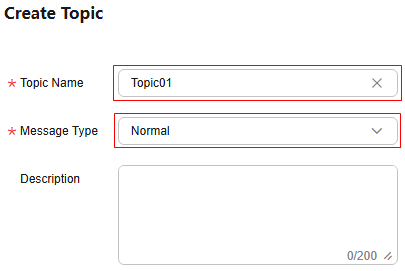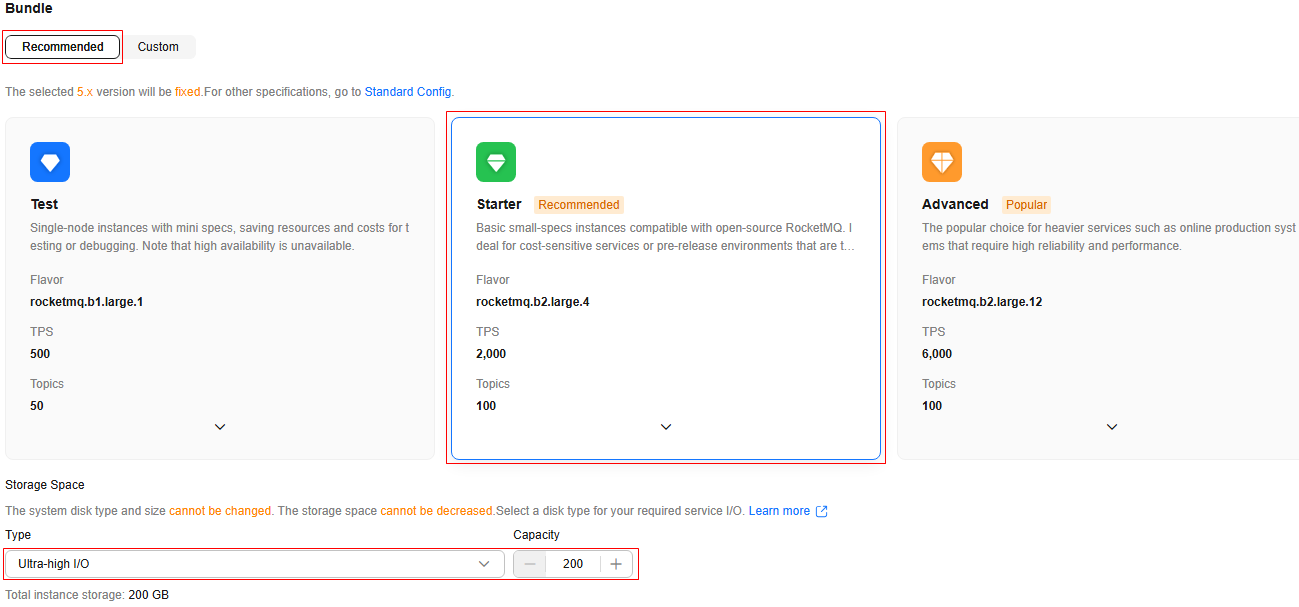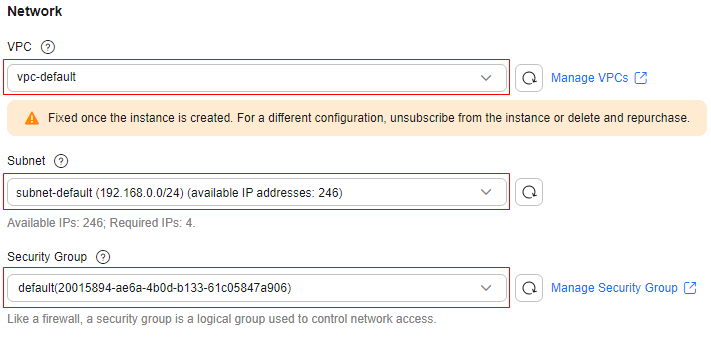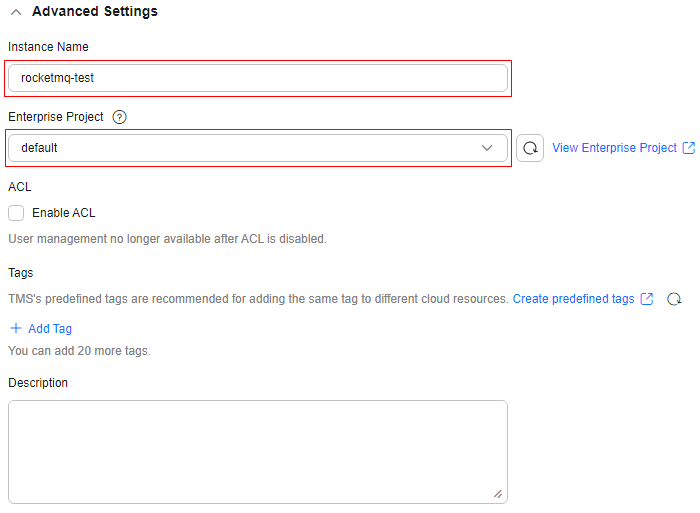Getting Started with RocketMQ to Produce and Consume Messages
This document takes the example of creating a RocketMQ instance with SSL enabled and accessing it on a client in the same VPC as the instance over a private network for message production and consumption to get you quickly started with Distributed Message Service (DMS) for RocketMQ.
Procedure

- Step 1: Preparations
Before creating a RocketMQ instance, an authenticated Huawei Cloud account with balance, users with required permissions, a set of Virtual Private Cloud (VPC) and subnet, a security group, an Elastic Cloud Server (ECS), and an environment should be prepared.
- Step 2: Create a RocketMQ Instance
Enable SSL, disable ACL, and configure the created VPC and subnet, and security group.
- Step 3: Create a Topic
After an instance is created, create a topic for sending and receiving messages.
- Step 4: Connect to a RocketMQ Instance to Produce and Consume Messages
On the client, connect to the instance and use commands to produce and consume messages.
Step 1: Preparations
- Register a HUAWEI ID.
Before creating a RocketMQ instance, register a HUAWEI ID. For details, see Signing up for a HUAWEI ID and Enabling Huawei Cloud Services.
If you already have a Huawei ID, skip this step.
- Grant RocketMQ instance permissions.
The RocketMQ administrator permission DMS FullAccess is required. For details, see Creating a User and Granting DMS for RocketMQ Permissions.
- Create a VPC and subnet.

The VPC must be created in the same region as the RocketMQ instance.
A RocketMQ instance runs in a Virtual Private Cloud (VPC). Before creating an instance, ensure that a VPC is available. For details about how to create a VPC and a subnet, see Creating a VPC and Subnet.
- Create a security group.
See Creating a Security Group.
To connect to RocketMQ instances, add the security group rules described in Table 1.
Table 1 Security group rules Direction
Protocol
Port
Source
Description
Inbound
TCP
8100
IP address or IP address range of the RocketMQ client
The port is used for private network access to instances using TCP.
Inbound
TCP
8080
The port is used for private network access to instances using gRPC.
Inbound
TCP
10100
The port is used for private access to service nodes using TCP.

After a security group is created, its default inbound rule allows communication among ECSs within the security group and its default outbound rule allows all outbound traffic. In this case, you can access a RocketMQ instance within a VPC, and do not need to add rules according to Table 1.
- Create an elastic cloud server (ECS) and configure environment variables.
The following takes a Linux ECS as an example. For more information about how to install JDK and configure the environment variables for a Windows ECS, please search the Internet.
- Log in to the console, click
 in the upper left corner, click Elastic Cloud Server under Computing, and then create an ECS.
in the upper left corner, click Elastic Cloud Server under Computing, and then create an ECS.
For details, see Purchasing an ECS. If you already have an available ECS, skip this step.
- Log in to an ECS as user root.
- Install the JDK and configure the environment variables JAVA_HOME and PATH.
- Download the JDK.

Use Oracle JDK instead of ECS's default JDK (for example, OpenJDK), because ECS's default JDK may not be suitable for the sample project. Obtain Oracle JDK 1.8.111 or later from Oracle's official website.
- Run the following command to decompress the JDK package.
tar -zxvf jdk-8u321-linux-x64.tar.gz
Change jdk-8u321-linux-x64.tar.gz to your JDK version.
- Run the following command to edit the environment variable file .bash_profile:
vim ~/.bash_profile
- Add the following content to the environment variable file:
export JAVA_HOME=/opt/java/jdk1.8.0_321 export PATH=$JAVA_HOME/bin:$PATH
Change /opt/java/jdk1.8.0_321 to the path where you install JDK.
- Press Esc to exit the editing mode and run the following command to save the environment variable file:
:wq
- Run the following command to make the environment variables take effect:
source .bash_profile
- Download the JDK.
- Run the following command to check whether the JDK is successfully installed.
java -version
If the following information is displayed, the JDK is installed successfully:java version "1.8.0_321"
- Run the following command to download the rocketmq-tutorial sample software package.
wget https://dms-demos.obs.cn-north-1.myhuaweicloud.com/rocketmq-tutorial.zip
- Run the following command to decompress rocketmq-tutorial.
unzip rocketmq-tutorial.zip
- Log in to the console, click
Step 2: Create a RocketMQ Instance
Before using RocketMQ for message production and consumption, create a RocketMQ instance. The VM resource in the instance store topics.
- Go to the Buy Instance page.
- On the Quick Config tab page, set basic instance configurations shown in Figure 2. Table 2 lists the configuration details.
Table 2 Setting instance basics Parameter
Description
Billing Mode
Select Pay-per-use, which is a postpaid mode. You can pay after using the service, and will be billed for your usage duration. The fees are calculated in seconds and settled by hour.
Region
DMS for RocketMQ instances in different regions cannot communicate with each other over an intranet. Select a nearest location for low latency and fast access.
Select EU-Dublin.
AZ
An AZ is a physical region where resources use independent power supply and networks. AZs are physically isolated but interconnected through an internal network.
Select an AZ.
- Set the instance specifications and storage space, as shown in Figure 3. For details, see Table 3.
Table 3 Setting the instance specifications and storage space Parameter
Description
Bundle
Choose Recommended > Starter. Basic small-specs instances are compatible with open-source RocketMQ. Ideal for cost-sensitive services or pre-release environments that are tolerant to latency or limited performance.
Storage Space
Select the disk type and specify the disk size as required.
After the instance is created, you cannot change the disk type.
Select Ultra-high I/O and enter 200.
- Configure the instance network as shown in Figure 4. For details, see Table 4.
Table 4 Configuring the instance network Parameter
Description
VPC
After the RocketMQ instance is created, its VPC cannot be changed.
Select the VPC prepared in 3.
Subnet
After the RocketMQ instance is created, its subnet cannot be changed.
Select the subnet prepared in 3.
Security Group
Select the security group prepared in 4.
- Set the instance access mode as shown in Figure 5. For details, see Table 5.
- Configure Advanced Settings, as shown in Figure 6. For details, see Table 6. Retain default settings for other parameters.
Table 6 Configuring advanced instance settings Parameter
Description
Instance Name
You can customize a name that complies with the rules: 4–64 characters; starts with a letter; can contain only letters, digits, hyphens (-), and underscores (_).
Enter rocketmq-test.
Enterprise Project
This parameter is for enterprise users. An enterprise project manages project resources in groups. Enterprise projects are logically isolated.
Select "default".
ACL
Enabling ACL can manage permissions for message production and consumption. Do not enable it here.
Tags
Identifiers of the RocketMQ instance. Skip it here.
Description
Additional information about the instance. Skip it.
- Click Confirm.
- Confirm the instance information and submit the request.
- Return to the instance list and check whether the RocketMQ instance has been created.
It takes 3 to 15 minutes to create an instance. During this period, the instance status is Creating.
- If the instance is created successfully, its status changes to Running.
- If an instance fails to be created, view it in the Instance Creation Failures area and delete it. Then create a new one. If the instance creation fails again, contact customer service.
- After the instance is created, click its name to go to the instance basic information page.
- Record the instance connection addresses for later use.
Figure 7 Recording instance connection addresses

Step 3: Create a Topic
A topic is the basic unit for sending and receiving messages. After creating a RocketMQ instance, you must manually create topics before creating and retrieving messages.
- Click a RocketMQ instance to go to the instance basic information page.
- In the navigation pane, choose Topics.
- Click Create Topic.
- Configure the topic name and other parameters by referring to Table 7.
Table 7 Topic parameters Parameter
Description
Topic Name
Enter a topic name. Enter Topic01 here.
Message Type
Select the message type. Select Normal here.
Description
Additional information about the topic. Skip it.
Figure 8 Creating a topic
- Click OK.
Step 4: Connect to a RocketMQ Instance to Produce and Consume Messages
- Go to the rocketmq-tutorial/bin directory on the ECS.
cd rocketmq-tutorial/bin
- Produce normal messages by the following commands.
The following is a command example:
JAVA_OPT=-Dtls.enable=true sh mqadmin sendMessage -n "10.xxx.xxx.89:8100;10.xxx.xxx.144:8100" -t Topic01 -p "hello rocketmq"

- Consume normal messages by the following commands.
The following is a command example:
JAVA_OPT=-Dtls.enable=true sh mqadmin consumeMessage -n "10.xxx.xxx.89:8100;10.xxx.xxx.144:8100" -t Topic01

The content of BODY is the consumed message content.
To stop consuming messages, press Ctrl+C to exit.
Related Information
- Learn more about RocketMQ Concepts.
- In RocketMQ instance creation, SSL can be disabled if ciphertext is not needed in access between the consumer client and the producer client. In this case, to access the RocketMQ instance, see Accessing a RocketMQ Instance Without SSL Enabled.
- To enable public access to RocketMQ instances, see Configuring Public Access.
Feedback
Was this page helpful?
Provide feedbackThank you very much for your feedback. We will continue working to improve the documentation.











